The shape of the dome and surround makes a big difference to the right profile to give a smooth response. Flatter domes tend to be easier as are narrow or concave surrounds. Taller domes tend to be hard to avoid self interference dips in the 10 to 15K range, but each will be behave differently. You can test it all out for yourself using the Source parameters in Ath or look back through augerpro's Open Source Waveguide thread where there was simulation of different options. By looking at his results and comparing them to the drivers can give you some idea of what to expect in general but only with the type of profile he used.
Yes I guess I meant "wider pattern", more acoustic power at off-axis too.
With regards to dome shape discussions I think you meant the following thread,
https://www.diyaudio.com/community/threads/open-source-waveguides-for-cnc-3d-printing.318190/
I did a quick search and it seems there are several posts discussing dome shapes, I will have a closer look at that thread and the amount of posts will give me a bit of reading, thanks.
@sheeple
That was a good reply, your answer seem to straighten out my questions marks I think, and yes, in my case I was thinking what I could get out of Ath for my own use in a home, so no extreme dB stuff although the increased efficiency is welcoming.
You mentioned compression driver which, I at least relate to PA stuff, I recall very faintly that the membrane material for horn use (and I guess this is also regarding for wg's as well as they seem to be closely related to each other, much more so than how a driver membrane acts on a flat baffle mount) the dome often seem to be made of a hard material like aluminum, titanium etc., is that so because of the higher acoustic load which makes soft domes becoming "floppy" and makes them give in much easier when wg or horn mounted, could that be a reason for why hard material membranes due to its pistonic motion higher up in frequency are usually working better in wg/horns, and perhaps providing a larger pattern?
Last edited:
Wide radiation pattern is not what are horns for 🙂
Isn't that a secondary and also a detrimental effect while the primary sought after effect with horns are higher efficiency?
:)edit: My thought train is going more in a compromise pattern, I am trying to figure out how to get the best of both worlds, ie. a controlled radiation pattern without it becoming too narrow, but not necessary as wide as when a driver is mounted directly on a flat baffle, something like that.
Last edited:
No, not at all. For a home environment it's quite the other way around...Isn't that a secondary and also a detrimental effect while the primary sought after effect with horns are higher efficiency?
You only have to be careful about the radiation pattern so it stays reasonably frequency-independent (i.e. well "controlled"). Horns can also progressively beam towards high frequencies easily and that's not what you want, for various reasons.
Last edited:
@mabat I agree, I was only commenting on horns specifically which I tend to separate from wg's although they are in many ways similar to each other, perhaps semantics and pettiness's.
But yes, if I now understand it the sought after attributes of wg's for home environment is to have a well shaped and narrow radiation pattern in order to minimizes the effect from room interaction, right?
But yes, if I now understand it the sought after attributes of wg's for home environment is to have a well shaped and narrow radiation pattern in order to minimizes the effect from room interaction, right?
:)Basically, yes. I use the terms horns and waveguides interchangeably, finding the distinction somewhat artificial. The thing is that with a waveguide one actually can achieve a very well controlled pattern. An exact beamwidth is probably not that important.
Got some ST260 printed while ago. Here is measurements with Faital Pro HF10AK driver, 15deg steps 0-180 horizontal measured and then mirrored in VCAD. Living room condition so window is perhaps 3-4ms. L-pad and capacitor was between amp and driver. Measured in application top of a woofer box so its in application response sans DSP. Polar graphs normalized, same data just few different views on it.
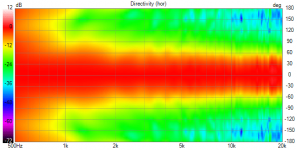
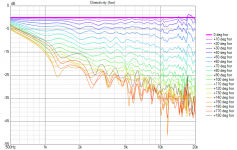
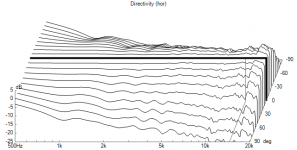
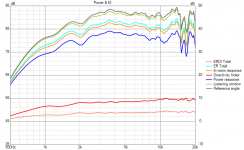
It has good sound to it, listening window response +-30deg is within ~1db 1-20kHz. Some diffraction visible and if it bothers, then experiment with roundover past 180deg / absorption backside of the device.




It has good sound to it, listening window response +-30deg is within ~1db 1-20kHz. Some diffraction visible and if it bothers, then experiment with roundover past 180deg / absorption backside of the device.
Last edited:
That doesn't have to be the waveguide. I would expect that making the roundover past 180deg won't improve anything, if not the opposite. Perhaps not intuitive but that's what simulations predict.Some diffraction visible. If it bothers, then experiment with roundover past 180deg / absorption backside of the device.
Oops, the graphs show response in 10 deg steps so listening window is within ~3db 😀
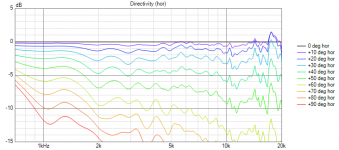
^ Yeah could be some from the woofer box below, or something. I remember from few years ago as you experimented with the roundover and 180deg seemed to yield best results overall.
Listening window is almost clean, there is some hints at 2kHz and 3kHz around 20-50deg. Feature far off axis >90deg angles are similar to what speaker boxes also have, which I think is sound around each side of the device interfering. "forward leaning ridges" type of thing is diffraction from "back edge". Here is the logic, roundover bit past 180deg might reduce ridge feature some although its mild already. Sound around the device might get some attenuation with damping material behind. Both something I'm not bothering with.
edit.
hmm. around 2kHz the driver has resonance and there is kink in group delay as well, perhaps its responsible for the anomaly in pattern there as well?
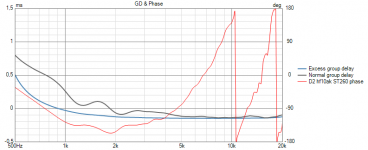

^ Yeah could be some from the woofer box below, or something. I remember from few years ago as you experimented with the roundover and 180deg seemed to yield best results overall.
Listening window is almost clean, there is some hints at 2kHz and 3kHz around 20-50deg. Feature far off axis >90deg angles are similar to what speaker boxes also have, which I think is sound around each side of the device interfering. "forward leaning ridges" type of thing is diffraction from "back edge". Here is the logic, roundover bit past 180deg might reduce ridge feature some although its mild already. Sound around the device might get some attenuation with damping material behind. Both something I'm not bothering with.
edit.
hmm. around 2kHz the driver has resonance and there is kink in group delay as well, perhaps its responsible for the anomaly in pattern there as well?

Last edited:
As the latest simulations showed, at 2 kHz (~17 cm wavelength) there's probably nothing inside a driver that could affect polar pattern, other than simply lower or increase the overall level. This is all what a resonance inside a driver does at such long wavelengths - it should be possible to simply EQ it out (including the group delay automatically - that really goes hand in hand - use minimum phase filter).
Yes for sure, but there is kink in off-axis that looks like diffraction around the same frequency 😉
Sure, but that won't be related to the resonance. Those are separate issues (the latter being perhaps a worse problem in general - not here I guess).
Ah I see what you ment now, separate thing. Ok so small dips in 2kHz and 3kHz ~20-50 degrees is interference from the measurement setup, either from the waveguide or something else like the woofer box.
Yeah, you could try to hang the waveguide in the air, free of near objects - it should disappear. Of course that's only academic anyway, in real there will be always some structure/woofer nearby - but at these levels I think there's nothing to really worry about. It will hardly get any better. Possible -probably, necessary - I doubt it.
BTW, not long ago I shared my measurements of the ST260 with FANE CD131:
https://www.diyaudio.com/community/...-design-the-easy-way-ath4.338806/post-7073209
As almost anything else with me lately, it has stayed half way. At least I've figured out how to make the supporting woofer enclosure -

https://www.diyaudio.com/community/...-design-the-easy-way-ath4.338806/post-7073209
As almost anything else with me lately, it has stayed half way. At least I've figured out how to make the supporting woofer enclosure -
Improving the loading does make it easier to cross CD's lower without it becoming overly complicated phase wise.
It also improves distortion in the lower end a bit.
I don't know if this is really a good thing to trade off for constant directivity.
This being said - a fir filter can take care of the phase issue and at low levels the distortion is not a problem.
Good points!
Someone made an elliptical (or rather oval) waveguide using ATH4. He prefers it to an Arai A290-FL, especially regarding 'imaging', but had a hard time finding a suitable 1" driver. He settled for a B&C DE500.Now I wonder what difference would an elliptical horn make.
Last edited:
- Home
- Loudspeakers
- Multi-Way
- Acoustic Horn Design – The Easy Way (Ath4)